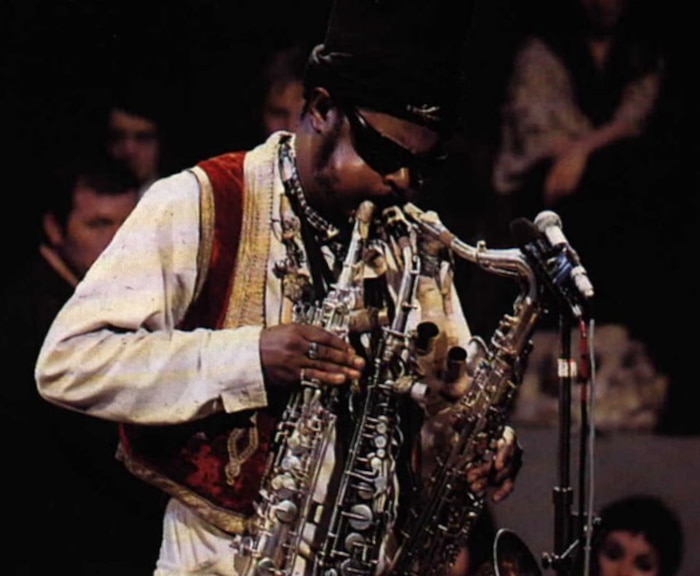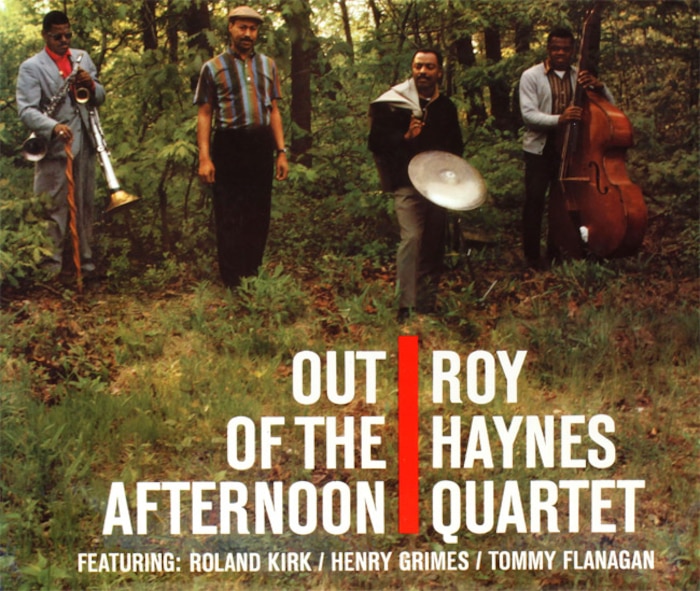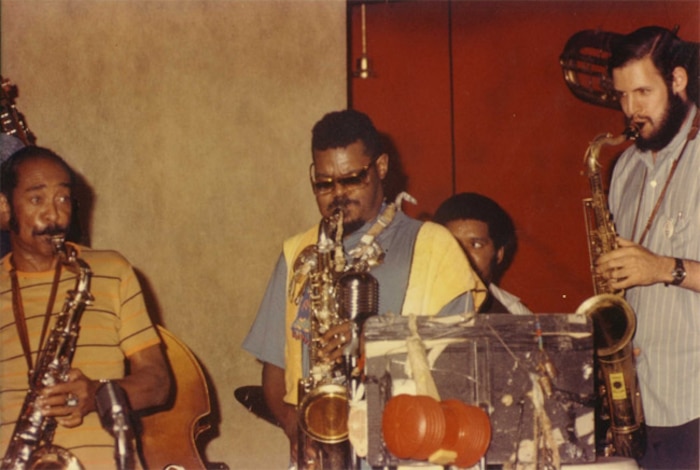Rahsaan Roland Kirk: The Seeker
Rahsaan Roland Kirk is the one who was playing all the weird instruments. The one who seemed to spend as much time at concerts talking as he did playing. The blind one. He’s also someone that doesn’t get celebrated in the same way as bigger names like John Coltrane, Charlie Parker and Miles Davis. But listening over his discography, it’s hard to deny his obvious talent. That’s why we asked Brad Shoup to jump in and tell you what you might be missing.

In the 12th-century epic The Song of Roland, Charlemagne’s nephew Roland uses his elephant-tusk horn to summon support in a losing battle. He blows so hard his temples explode, earning him a martyr’s death and a trip to Heaven, no waiting.
Rahsaan Roland Kirk arrived on Earth with only one of those three names. But his name, like his instruments – and even jazz itself – was just so much malleable material. Kirk perpetually reserved the right to combine free and fixed, order and chaos, technique and idiosyncrasy, in whichever way he wanted. Sometimes he knew what he wanted because it arrived in a dream. A dream gave him the name “Rahsaan”; it was in a dream that he arrived at the concept of playing multiple instruments simultaneously. It’s trite as hell to say that the artist’s job is to give expression to whatever’s in his or her head. But Rahsaan absolutely could not stop translating. In his 22-year career in jazz, he personally employed some four dozen instruments in the construction of his unique vocabulary.
Kirk first attained fame with his ability to play three brass instruments at once. He didn’t invent the technique, but he was one of the few for whom it was a means to an expressive end. Whether in jazz, rock or pop, if you’re chasing a specific musical combination, you hire sidemen, or you overdub. To play multiple instruments at once is to risk diffusing your power, or becoming a sideshow.

For his entire musical career, Kirk took that risk head-on, although perhaps there are no risks for the stubborn. Born Ronald Theodore Kirk in Columbus, Ohio in 1935, his first musical experiments were around age five; he cut off a section of garden hose, blowing into it as practice for playing the bugle. In John Kruth’s Kirk biography Bright Moments, bassist and one-time Kirk bandleader Bruce Woody recalled the image of Kirk laying beside the neighborhood Baptist church, blowing that tube while the band played inside.
Kirk eventually worked his way up to the saxophone, cutting his teeth in a number of local R&B acts; often, he was billed as the “Walking Blind Man,” tasked with taking his solo while navigating the club. (His bandmates maintained he never made a misstep.) But Kirk was hearing other sounds. Still a teenager, he started assembling his odd sonic arsenal, working with music-shop owners to modify obscure instruments to his purposes. The saxello soprano (once used by Spanish military bands) became the manzello; a limited-run straight alto sax became the stritch; a slide trombone and a sax mouthpiece became the surolophone.
From there, he spent a lifetime woodshedding instrumental combinations, either in sequence or parallel. And while he relished the chance to “cut” other saxophonists onstage – his battle with George Adams at a Charles Mingus Carnegie Hall date set Mingus cackling with glee – there was always a distinctly Kirkian quality to his playing. He developed a circular breathing technique that enabled him to reel off notes as long as some folks’ solos.
The second side of his 1973 LP Prepare Thyself to Deal With a Miracle was given over to his “Saxophone Concerto,” a jaw-dropping, 21-minute trip through black musical history taken on a single breath. He’d double or triple lines, set a classical progression up with a jazz-standard counterpoint, chase a melody back and forth through history. He could do post-bop fireworks, and even if he never swung as hard as his beloved New Orleans forebears, he could (figuratively) walk the bar. Time and again, though, he returned to those simultaneous lines, and the weird and beautiful tonal serrations that resulted. It was never his intent to replicate a regular brass section, because it couldn’t yield the sounds he heard.
Perhaps his greatest stylistic contributions, though, were on the flute, which in his hands discharged timbral possibilities at unprecedented speed. Huffing, singing and grunting through his instrument, he captured the awesome messiness of humanity (and heavily influenced Jethro Tull, for good or ill). 1964’s I Talk With the Spirits – his only all-flute album – revealed the extent of his studies, running the gamut from a tone-poetic duet with a Japanese music box to his signature dialogues in overtone. Prepare Thyself’s “Seasons – One Mind Winter/Summer/Ninth Ghost” begins with a fugue for both standard and nose flute. Kirk leans into Henry Pearson’s groaning lullabye bass, turning themes inside-out in celestial bliss; Rahsaan being Rahsaan, he calls heaven down with scuffing and talking, cackling and cooing.
Didn’t matter if he had a flute or a mic: Kirk loved to talk. It was just another part of his sonic skillset. “I’m a musician,” Miles Davis once said. “I ain’t no comedian. I don’t go shooting my mouth off like Rahsaan Roland Kirk.” For many audiences and more than a few musicians, a Rahsaan show could be a discomfiting experience. At his pleasure, he would launch into a history lesson, drop some raunch, drift into whimsy, tear into Nixon (a favorite target), or challenge a heckler to take it outside. In a sense, Kirk’s monologues – which pop up throughout his catalog – put the lie to the idea that he was just a gimmick, that he wasn’t keenly aware of his place in history. In another sense, they were themselves peculiar music.

To watch Kirk in action was to see wonders unfold in real time: a one-man brass factory in knit cap and vinyl jumpsuit, always steaming, constantly adjusting the mic, switching between a clutch of instruments dangling from his neck like the gaudiest medallions, all to push the audience toward the ecstatic reception he craved. Free players marveled at his single-minded pursuits; the more traditional post-boppers noted his gift for shooting, say, Sidney Bechet into space. He didn’t appear on others’ recording sessions much, but when he did (for Roy Haynes, Quincy Jones and Charles Mingus, to name three heavy hitters), his manzello and stritch were invariably in tow. Those instruments earned him a longstanding residency in the Down Beat critics’ polls – in the “Misc. Instrument” category. (It forever galled him that in the Flute category, he always lost to Herbie Mann – the hirsute, bird-toned white crossover act.)
It seemed he was always spoiling for respect, a fight or both. With the help of friend Mark Davis, Kirk formed the Jazz & People’s Movement in 1970, designed to create exposure for jazz musicians in a variety of settings and media. Pointing up the disconnect between a still-fertile jazz scene and its invisibility in a media landscape zoned for white rock acts, the J&PM attracted co-signs from dozens of musicians and club owners. Up to 80 collaborators at a time would descend upon the Guggenheim Foundation (for largely ignoring black artists) and tapings of the Dick Cavett and Merv Griffin’s talk shows, blowing whistles and waving placards. Warned by the J&PM of an upcoming disruption, The Ed Sullivan Show capitulated, inviting Kirk to perform “My Cherie Amour.” Kirk accepted, insisting on an all-star group that included Archie Shepp, Charles Mingus and Roy Haynes. But instead of Stevie’s hit, the viewing audience got their ears pinned back by a thunderous six minutes of Mingus’ “Haitian Fight Song.”

Don Byas, Rahsaan Roland Kirk, Sonny Brown, Mattathias Pearson Credit: Neal Graham
With that, the Jazz & People’s Movement essentially disbanded, and Kirk took the fight back to wax. Even without an accompanying lecture, his pieces increasingly tended toward disquisition, moving nimbly from post-bop to free to Dixieland, channeling Dvorak and Byas, celebrating the whole of what he often termed “black classical music.” He cut Coltrane’s fiendishly difficult “Giant Steps” on the same LP as Minnie Riperton’s “Loving You.” (He had a weakness for Motown, and even deigned to quote the coda of “Hey Jude” on his soul-jazz masterpiece “Volunteered Slavery.”) He suffered a stroke in 1975 and willed himself back into form, modifying his instruments for one-handed use.
In just 42 years, Rahsaan Roland Kirk demanded a host of creative and personal rights. Some – major-label freedom, the respect of his peers, financial stability – he received. Others eluded him, due to discrimination or the nature of his endless quest. He was no Coltrane, taking a singular idea of freedom into the cosmos. Neither was he Charlie Parker, who applied theoretical rigor as he approached bebop’s endpoint. To Kirk, sound was everything and everything was sound, and he made as much of it as his body would allow. He was a constant reminder of Black America’s cultural ascendance, and its continuing surprises for those with ears to hear and the will to conjure.